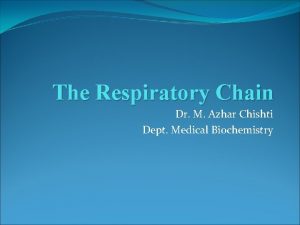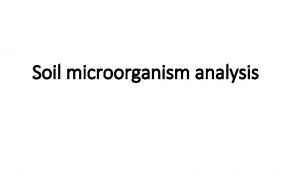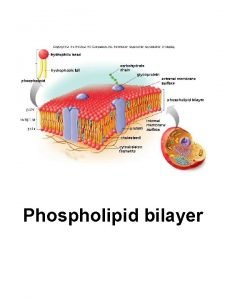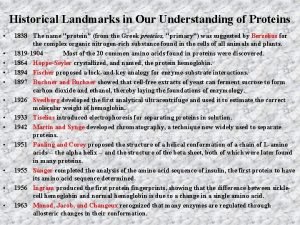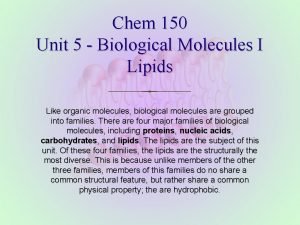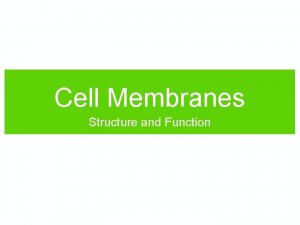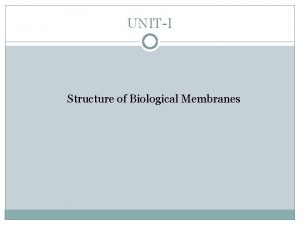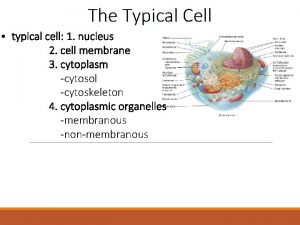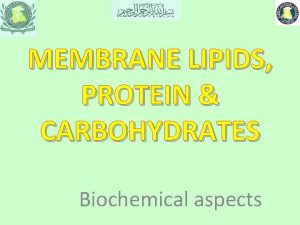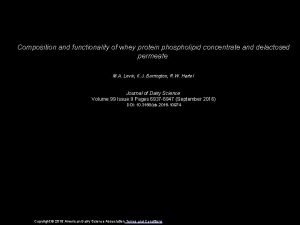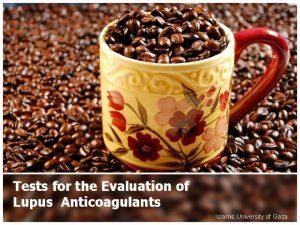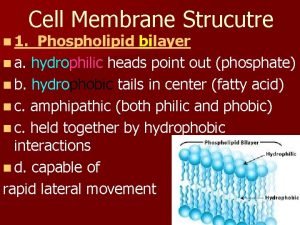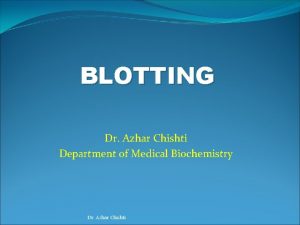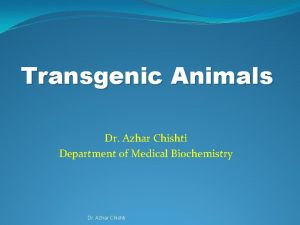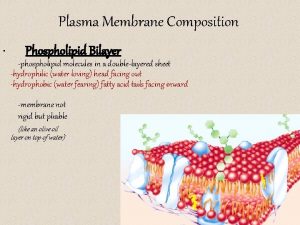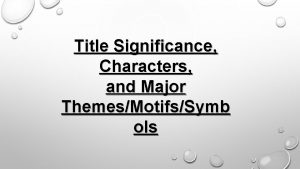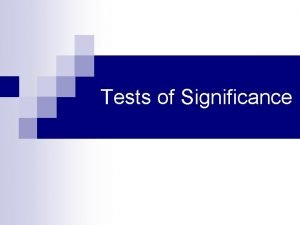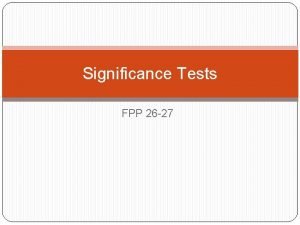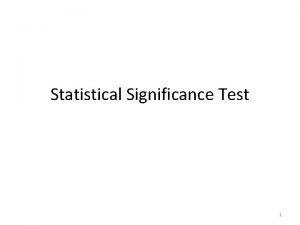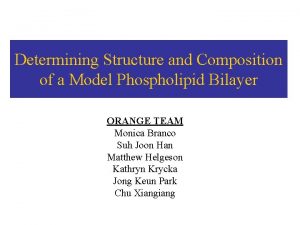Phospholipid and significance Dr M Azhar Chishti Dept














































- Slides: 46

Phospholipid and significance Dr. M. Azhar Chishti Dept. Medical Biochemistry

Lecture Objective 1. 2. 3. To study the structure of physiologically important phospholipid classes- glycerophospholipids and sphingolipids. To discuss the synthesis of phospholipids of clinical and physiological relevance and their degradation by phospholipases. To study the role of phospholipids like phosphatidylinositol in signal transduction and membrane anchoring choline, ethanolamine and serine, cardiolipin and sphingomyelin etc.

Lecture Outline 1. Overview of phospholipids. 2. Structure of Glycerophospholipids and sphingolipids. 3. Synthesis of phospholipids: Phosphatidic acid, phosphatidyl-choline, ethanolamine and serine, cardiolipin and sphingomyelin etc. 4. Degradation of phospholipids by phosphalipases. 5. Role of phosphatidyl choline in lung surfactant 6. Role of phsophatidylinositol in signal transduction and membrane anchoring.

Phospholipid § Polar compounds composed of alcohol attached by a ﺑـ ﻣﺮﺑﻮﻁ ﺭﺍﺑﻄﻪ phosphodiester bridge to either diacylglycerol or sphingosine. § Amphipathic ( ﻟﻠﻤﺎﺀ ﻭﻛﺎﺭﻩ ﻣﺘﺮﺩﺩ ) ﻣﺤﺐ in nature, has a hydrophilic head (phosphate + alcohol eg. , serine, ethanolamine, and choline) and a long, hydrophobic tail (fatty acids or derivatives ). § In membranes, the hydrophobic portion is associated with the nonpolar portions such as glycolipids, proteins, and cholesterol. § The hydrohilic polar head extends outward, facing intracellular or extracellular aqueous environment (see Figure).


§ Membrane phospholipids also function as : 1 - a reservoir ﺣﺎﻓﻆ for intracellular messengers, and, 2 -for some proteins, phospholipids serve as anchors ( ﻣﺮﺳﺎﻩ ) ﻣﺜﺒﺖ to cell membranes. § Non-membrane-bound phospholipids ﻓﻲ ﻳﺪﺧﻞ ﻟﻢ ﺍﻟﺬﻱ ﺍﻟﻔﻮﺳﻔﻮﻟﺒﺪﺯ : ﻭﻇﻴﻔﻪ ﺍﻟﺨﻠﻮﻳﻪ ) ﺣﺮ ( ﻟﻪ ﺍﻟﺠﺪﺭ ﺗﺮﻛﻴﺐ serve additional functions in the body, for example, 1 -as components of lung surfactant and 2 -essential components of bile, where their ﻫﻲ ﺍﻟﺒﺎﻳﻞ ﺗﻨﻈﻴﻒ ﻭﻇﺎﺋﻒ ﻟﻪ ﺍﻟﺬﻱ ﺍﻟﻤﻜﺎﻥ detergent properties aid "in the solubilization of cholesterol. ﺍﻟﻜﻠﻮﻳﺴﺘﺮﻭﻝ ﺍﺧﺮﺍﺝ ﻣﺜﻞ

ﺍﺭﺗﺒﺎﻃﺎﺕ ﺍﻟﻔﺴﻔﻮﻟﺒﺪﺯ ﺑﺎﻟﺠﻠﻴﺴﺮﻭﻝ : ﺍﻭﻻ Glycerophospholipids : are formed from phosphatidic acid (PA) and an alcohol. �Serine + phosphatidylserine (PS) PA � � Ethanolamine + PA - phosphatidylethanolamine (cephalin) � Choline + PA - phosphatidylcholine (lecithin) PC � Inositol + PA - phosphatidylinositol (PI) Glycerol + PA phosphatidylglycerol (PG)

(Cardiolipin) ﻓﺴﻔﻮﻟﺒﺪﺯ ﺍﺳﻢ ﺍﻟﺰﻫﺮﻱ ﻣﺮﺽ ﻋﻠﻰ ﻟﻠﺪﻻﻟﻪ ﻳﺴﺘﺨﺪﻡ Two molecules of phosphatidic acid esterified through phosphate to an additional molecule of glycerol are called cardiolipin. This is the only human glycerophospholipid that is antigenic. cardiolipin is recognized by antibodies raised against Treponema the bacterium that causes syphylis ﺍﻟﺰﻫﺮﻱ. [Cardiolipin is an important component of the inner mitochondrial membrane and bacterial membranes. ]

Plasmalogens When the fatty acid at carbon 1 of a glycerolphospholipid is replaced by an unsaturated alkyl group attached by an ether ﺍﻳﺜﺮ ﺭﺍﺑﻄﻪ (rather than ﻣﻦ ﺑﺪﻻ by an ester) linkage ﻣﻬﻤﻪ to the core glycerol : molecule, a plasmalogen is produced. Phosphatidalethanolamine is abundant ﺑـ ﻏﻨﻲ in nerve tissue is a plasmalogen. Phosphatidalcholine (abundant in heart muscle) is the other quantitatively ﻛﻤﻴﻪ significant ether lipid in mammals.


Platelet-activating factor (PAF) � PAF is an unusual ether ﺍﻳﻀﺎ ﺍﻳﺜﺮ ﺑﺮﺍﺑﻄﻪ ﻣﺮﺗﺒﻂ glycerophospholipid, with a saturated alkyl group ﻣﺸﺒﻌﻪ ﺭﺍﺑﻄﻪ ﻟﺪﻳﻬﺎ ﺍﻥ -1 ﻗﺒﻞ ﺍﻟﻠﻲ ﻋﻦ ﺗﺨﺘﻠﻒ in an ether link to carbon 1 and ﺍﻟﺜﺎﻧﻲ ﺍﻻﺧﺘﻼﻑ >>>2 - an acetyl residue (rather than a fatty acid) at carbon 2 of the glycerol backbone. PAF is synthesized and released by a variety of cell types that binds to surface receptors, triggering potent ﻗﻮﻱ thrombotic and acute inflammatory leads to hypersensitivity & anaphylactic ﻓﻌﻞ ﺭﺩﻭﺩ ﻣﻨﺎﻋﻴﻪ reactions. It causes platelets to aggregate and degranulate the neutrophils and alveolar macrophages to generate superoxide radicals that killed the bacteria. PAF is one of the most potent bioactive molecules known, causing effects at concentrations as low as 10 -12 mol/L.

ﺍﺭﺗﺒﺎﻁ ﺍﻟﻔﺴﻔﻮﻟﺒﺪﺯ ﺑﺎﻟﺴﻔﻴﻨﻘﻮ : ﺛﺎﻧﻴﺎ Sphingophospholipids or sphingomyelin The backbone of sphingomyelin is the amino alcohol sphingosine, rather than glycerol. A long-chain fatty acid is attached to the amino group of sphingosine through an amide linkage ﺑﻌﺾ ﻓﻲ ﺍﻭ ﻛﺎﻥ ) ﺍﺳﺘﺮ ﻗﺒﻞ ﺍﻟﻠﻲ ( ﺍﻳﺜﺮ ﺍﻟﺤﺎﻻﺕ , producing a ceramide, which serve as a precursor of glycolipids. to � ﻣﻬﻤﻪ : The alcohol group at carbon 1 of sphingosine is esterified phosphorylcholine, producing sphingomyelin, the only significant sphingophospholipid in humans. Sphingomyelin is an important componant of the myelin of nerve fibers (myelin sheath) that insulates and protects neuronal fibers of the central nervous system.


Synthesis of Phospholipid 1. Glycerophospholipid (GP) synthesis involves : ﺑـﺎﻣﺎ ﺗﺘﻢ ﺍﻟﺘﺼﻨﻴﻊ ﻃﺮﻕ either the 1 - donation of phosphatidic acid from CDP-diacylglycerol to an alcohol, or 2 - the donation of the phosphomonoester of the alcohol from CDP-alcohol to 1, 2 -diacylglycerol. CDP is cytidine diphosphate. 2. In both cases, the CDP-bound structure is considered an "activated intermediate, " and CMP is released as a side product of GP synthesis. 3. A key concept in phosphoglyceride synthesis, is activation either of diacylglycerol or the alcohol to be added by linkage with CDP. ﺍﻧﻈﺮ ﺍﻟﺮﺳﻤﻪ ﺍﻟﺼﻔﺤﻪ ﺍﻟﻘﺎﺩﻣﻪ ﺗﺮﻳﺤﻚ ﻣﻦ ﺻﺪﺍﻉ ﺍﻟﺮﺍﺱ ﻫﺬﺍ


4. The fatty acids esterifies to the glycerol alcohol groups can vary widely, contributing to the heterogeneity of this group of compounds. 5. Phospholipids are ﻣﻬﻤﻪ synthesized in the Smooth ER-- then transported to Golgi apparatus and then membranes organelles or plasma membrane, or are secreted by exocytosis ﺍﻟﺨﻠﻮﻱ ﺍﻻﺧﺮﺍﺝ. 6. There are two classes of phospholipids: Those have either glycerol as a backbone or contain sphingosine. ﻗﺒﻞ ﻣﻦ ﺷﺮﺡ ﻛﻤﺎ 7. Both classes are found in membranes and play a role in the generation of lipid-signaling molecules.

A. Synthesis of phosphatidic acid (PA) 1. PA is the precursor ﺍﻻﻭﻟﻴﻪ ﺍﻟﻤﺎﺩﻩ of many other phosphoglycerides. The steps in its synthesis from glycerol phosphate and two fatty acyl Co. As were in which PA is shown as a precursor of triacylglycerol. 2. All cells except mature erythrocytes can synthesize phospholipids, whereas triacylglycerol synthesis occurs only in liver, adipose tissue, lactating mammary glands, and intestinal mucosal cells.

B: Synthesis of phosphatidylethanolamine (PE) & phosphatidylcholine (PC) • PC & PE are most abundant phospholipids in eukaryotic ﺍﻟﻤﺨﻠﻮﻗﺎﺕ ﺍﻟﻨﻮﺍﻩ ﺣﻘﻴﻘﻪ cells. • The primary route of synthesis uses choline and ethanolamine obtained either from the diet or turnover ﺗﺼﻨﻴﻊ ﺍﻋﺎﺩﻩ of the body's phospholipids. ﻣﻬﻤﻪ In the liver, PC also can be synthesized from phosphatidylserine (PS) and PE. •

1. Synthesis of PE and PC from preexisting choline and ethanolamine These synthetic pathways involve the phosphorylation of choline or ethanolamine by ﺍﻧﺰﻳﻢ kinases, followed by conversion to the activated form, CDP-choline or CDP-ethanolamine ﺍﻟﻰ ﺍﺭﺟﻊ ﺗﺘﻮﺿﺢ ﻟﻜﻲ ﺍﻟﻔﺴﻔﻮﻟﺒﺪﺯ ﻟﺘﺼﻨﻴﻊ ﺍﻟﺜﺎﻧﻴﻪ ﺍﻟﻄﺮﻳﻘﻪ. Finally, choline-phosphate or ethanolamine-phosphate is transferred from the nucleotide (leaving CMP) to a molecule of diacylglycerol (see Figure 17. 5). Significance of choline reutilization ﺍﺳﺘﻌﻤﺎﻝ ﺍﻋﺎﺩﻩ : The reutilization of choline is important because, whereas humans can synthesize choline de novo, the amount made is insufficient for our needs. Thus, choline is an essential dietary nutrient with an adequate intake of 550 mg for men and 420 mg for women.

Role of PC in lung surfactant 1. The principal pathway for the synthesis of dipalmitoylphosphatidylcholine 2 ﺭﻗﻢ ﺍﻧﻈﺮ ﻟﻠﺴﻴﺮﻓﺎﻛﺘﻴﻨﺖ ﺍﻻﺳﺎﺳﻲ ﺍﻟﺘﺮﻛﻴﺐ ﻓﻲ (ﺩﺍﺧﻠﻪ DPPC, or dipalmitoylecithin). In DPPC, positions 1 and 2 on the glycerol are occupied by palmitate. 2. DPPC, made and secreted by granular pneumocytes, is the major lipid component of lung surfactant--the extracellular fluid layer lining the alveoli. 3. Surfactant serves to decrease the surface tension of this fluid layer, reducing the pressure needed to reinflate alveoli, thereby preventing alveolar collapse (atelectasis). 4. Respiratory distress syndrome (RDS) in pre-term infants is associated with insufficient surfactant production, and is a significant cause of all neonatal deaths in western countries. 5. Lung maturity of the fetus can be gauged by determining the ratio of DPPC to sphingomyelin, usually written as the L (for lecithin)/S ratio, in amniotic fluid.

6. A ratio of 2 or above ( ﺍﻟﺴﻠﻴﻤﻪ ) ﻣﻬﻤﻪ ﺍﻟﻨﺴﺒﻪ is evidence ﺩﻟﻴﻞ of maturity, because it reflects the major shift from sphingomyelin to DPPC synthesis that occurs in the pneumocytes at about 32 weeks of gestation. 7. ( )ﺍﻟﻌﻼﺝ ﻣﻬﻤﻪ 1 - Lung maturation can be accelerated ﺗﺴﺮﻉ by giving the mother glucocorticoids shortly before delivery. ﺍﺧﺮﻯ ﻃﺮﻳﻘﻪ 2 -Administration of natural or synthetic surfactant (by intratracheal instillation ﻋﺒﺮ ﺗﻘﻄﻴﺮ ﺍﻟﻬﻮﺍﺋﻴﻪ )ﺍﻟﻘﺼﺒﻪ is also used in the prevention and treatment of infant RDS. 8. Respiratory distress syndrome due to an insufficient amount of surfactant can also occur in adults whose surfactant producing pneumocytes have been damaged or destroyed, for example, as an adverse side effect of immuno-suppressive medication or chemotherapeutic drug use.

2: Synthesis of PC from phosphatidylserine (PS) in liver ﻣﻬﻢ ﺍﻟﻤﻜﺎﻥ : 1. The liver requires a mechanism for producing PC, even when free choline levels are low, because it exports ﺗﺼﺪﺭ significant amounts of PC in the bile and as a component of serum lipoproteins. 2. To provide the needed PC, PS is decarboxylated ﺍﻟﻰ ﺗﺤﻮﻝ to phosphatidylethanolamine (PE) by ﺍﻧﺰﻳﻢ ﺑﻮﺍﺳﻄﻪ PS decarboxylase, an enzyme requiring pyridoxal phosphate as a cofactor. 3. PE then undergoes 3 methylation steps to produce PC, as illustrated in Figure 17. 6. 4. S-adenosylmethionine (SAM) is the methyl group donor lead to S -adenosylhomocysteine


C. Phosphatidylserine (PS) The primary pathway for synthesis of PS in mammalian tissues is provided by the base exchange reaction, in which the ethanolamine of PE is exchanged for free serine (see Figure 17. 6). This reaction, although reversible, is used primarily to produce the PS required for membrane synthesis.

Phospholipid Lectuer#2

D. Phosphatidylinositol (PI) PI is synthesized from free inositol and CDP-diacylglycerol as shown in Figure 17. 5. ﺑﺎﻟﻄﺮﻳﻘﻪ ﺻﻨﺎﻋﺘﻪ ﻭﻳﻤﻜﻦ ﺍﻟﻔﺴﻔﻮﻟﺒﺪﺯ ﻟﺼﻨﺎﻋﻪ ﺍﻻﻭﻟﻰ ﺍﻟﻄﺮﻳﻖ ﺍﻟﻘﺎﺩﻣﻪ ﺍﻟﺸﺮﻳﺤﻪ ﻓﻲ ﻛﻤﺎ ﺍﻟﺜﺎﻧﻴﻪ ﻣﻬﻤﻪ : PI is an unusual phospholipid in that it often contains stearic acid on carbon 1 and arachidonic acid on carbon 2 of the glycerol. ﺟﺪﺍ ﻣﻬﻤﻪ PI, therefore, serves as a reservoir ﺧﺎﺯﻥ of arachidonic acid ) ( ﺍﻻﻟﺘﻬﺎﺏ ﻋﻮﺍﻣﻞ ﺍﻟﻰ ﺗﺘﺤﻮﻝ ﺍﻭﻟﻴﻪ ﻣﺎﺩﻩ ﻫﻮ ﺍﺳﺪ ﺍﻻﺭﻛﺎﻧﻴﻮﺩ : ﻣﻌﻠﻮﻣﻪ in membranes and, thus, provides the substrate for prostaglandin ﺍﻟﺘﻬﺎﺏ ﻋﺎﻣﻞ synthesis when required.


1. Role of PI in signal transmission ﺍﻻﺷﺎﺭﻩ ﻧﻘﻞ across membranes: a. The phosphorylation of membrane-bound phosphatidylinositol produces polyphosphoinositides, for example, phosphatidylinositol 4, 5 - bisphosphate (PIP 2). b. The degradation of PIP 2 by phospholipase C occurs in response to the binding of neurotransmitters, hormones, and growth factors to receptors on the cell membrane (Figure 17. 8). c. The products of this degradation, inositol 1, 4, 5 -trisphosphate (IP 3) and diacylglycerol (DAG), mediate the mobilization of intracellular calcium and the activation of PKC, which act synergistically to evoke ﻳﺴﺘﺪﻋﻲ specific cellular responses. Signal transmission across the membrane is completed.



2. Role of PI in membrane protein anchoring ﺗﺪﻋﻴﻢ a. Specific proteins can be covalently ﺗﺴﺎﻫﻤﻴﻪ ﺑﺮﺍﺑﻄﻪ attached via a carbohydrate bridge to membrane bound PI (Figure 17. 9). b. Examples of such proteins include alkaline phosphatase (a digestive enzyme found on the surface of the small intestine that attacks organic phosphates), and acetylcholine esterase (an enzyme of the postsynaptic membrane that degrades the neurotransmitter acetylcholine). c. Cell surface proteins bound to glycosyl phosphatidylinositol (GPI) are also found in a variety of parasitic protozoans ﺍﻟﻄﻔﻴﻠﻴﺎﺕ (for example, Trypanosomes and Leishmania).


d. Being attached to a membrane lipid rather than being an integral part of the membrane) allows GPI-anchored proteins rapid lateral mobility on the surface of the plasma membrane. e. The protein can be cleaved from its anchor by the action of phospholipase C ﻣﻬﻤﻪ releasing diacylglycerol. f. A deficiency in the synthesis of GPI in hematopoietic ﺍﻟﺪﻡ ﺗﻜﻮﻳﻦ cells results in a hemolytic disease, paroxysmal nocturnal hemoglobinuria.

E. Phosphatidylglycerol (PG) and cardiolipin v v PG occurs in relatively large amounts in mitochondrial membranes and is a precursor of cardiolipin. It is synthesized by a two-step reaction from CDPdiacylglycerol and glycerol 3 -phosphate. v Cardiolipin (diphosphatidylglycerol, is composed of two molecules of phosphatidic acid connected by a molecule of glycerol. v It is synthesized by the transfer of diacylglycerophosphate from CDP-diacylglycerol to a preexisting molecule of phosphatidylglycerol.

F. Sphingomyelin q Sphingomyelin, a sphingosine-based phospholipid, is a ﻣﻬﻤﻪ major structural lipid in the membranes of nerve tissue. q The synthesis of sphingomyelin is shown in Figure, Briefly, palmitoyl Co. A condenses with serine, as coenzyme A and the carboxyl group (as CO 2) of serine are lost. q This reaction, like the decarboxylation reactions involving amino acids, requires pyridoxal phosphate (a derivative of vitamin B 6) as a coenzyme.

q The product is reduced in an NADPH-requiring reaction to sphinganine, which is acylated at the amino group with one of a variety of long-chain fatty acids, and then desaturated to produce ﻣﻬﻤﻪ a ceramide--the immediate precursor of sphingomyelin. q ﻣﻬﻤﻪ A ceramide with a fatty acid thirty carbons long is a major component of skin, and regulates skin's water permeability. q Phosphorylcholine from phosphatidylcholine is transferred to the ceramide, producing sphingomyelin and diacylglycerol. q Sphingomyelin of the myelin sheath contains predominantly ﺩﺍﺋﻤﺎ longer-chain fatty acids such as lignoceric acid and nervonic acid. whereas gray matter of the brain has sphingomyelin that contains primarily stearic acid.

IV. DEGRADATION OF PHOSPHOLIPIDS v The degradation of phosphoglycerides is performed by phospholipases ﺟﺪﺍ ﻣﻬﻤﻪ found in all tissues and pancreatic juice. v A number of toxins and venoms ﺳﻤﻮﻡ have phospholipase activity, and several pathogenic bacteria (Baccili) produce phospholipases that dissolve cell membranes and allow the spread of infection. v ( ﺧﺎﺻﻪ ﻣﻬﻤﻪ ) ﺣﺎﻟﻪ Sphingomyelin is degraded by the lysosomal phospholipase, sphingomyelinase. �

A. Degradation of phosphoglycerides a. Phospholipases hydrolyze ﻳﻜﺴﺮ the phosphodiester bonds of phospho- glycerides, with each enzyme cleaving phospholipid at a specific site. b. The major enzymes responsible for degrading phosphoglycerides are shown in Figure. c. Removal of the fatty acid from carbon 1 or 2 of a phosphoglyceride produces a lysophosphoglyceride, which is the substrate for lysophospholipases. d. Phospholipases release molecules that can serve as messengers (DAG and IP 3), or that are the substrates for synthesis of messengers (arachidonic acid).


e. ﻣﻬﻤﻪ Phospholipases are responsible not only for degrading phospholipids, but also for "remodeling ﺍﺷﻜﺎﻟﻬﻢ "ﺗﻐﻴﻴﺮ them. f. For example, phospholipases A 1 and A 2 remove specific fatty acids from membrane-bound phospholipids; these can be replaced with alternative fatty acids using fatty acyl Co. A transferase. g. This mechanism is used as one way to create the unique lung surfactant, dipalmitoylphosphatidylcholine (see p. 202), and to insure that carbon 2 of PI (and sometimes of PC) is bound to arachidonic acid.

B. Degradation of sphingomyelin a. ﻣﺮﺣﻠﺘﻴﻦ ﻋﻠﻰ ﺍﻟﻔﺼﻞ ﻳﺘﻢ 1 -Sphingomyelin is degraded by sphingomyelinase, a lysosomal enzyme that hydrolytically removes phosphorylcholine, leaving a ceramide ﻣﻬﻤﻪ. 2 -The ceramide is, in turn, cleaved by ceramidase into sphingosine and a free fatty acid (Figure 17. 12). b. The ceramide and sphingosine released by the degradation of sphingomyelin play a role as intracellular messengers. c. ﻣﻬﻤﻤﻪ Ceramides appear to be involved In the response to stress, and sphingosine inhibits protein kinase C. d. ﻣﻬﻤﻪ Niemann-Pick disease (Types A and B) is an autosomal recessive disease caused by the inability to degrade sphingomyelin. The deficient enzyme is sphingomyelinase-A type of phospholipase C.

e. In the severe infantile form (type A), the liver and spleen are the primary sites of lipid deposits and are, therefore, tremendously enlarged. The lipid consists primarily of the sphingomyelin that cannot be degraded (Figure 17. 13). f. Infants with this disease have rapid, progressive neurodegeneration deposition of sphingomyelin in CNS, and they die in early childhood. g. A less severe variant (type B) causes little to no damage to neural tissue, but lungs, spleen, liver, and bone marrow are affected, resulting in a chronic form of the disease, with a life expectancy only to early adulthood.

h. Although Niemann-Pick disease occurs in all ethnic groups. both type A and B occur with greater frequency in the Ashkenazi Jewish ( ﺍﺷﻨﺎﻛﺎﺯ ) ﺍﺣﺴﺴﺴﺴﺴﺴﻦ ﻳﻬﻮﺩ population than in the general population. i. In the Ashkenazi Jewish population, the incidence of type A is 1: 40, 000 live births, and that of type B is 1: 80, 000. j. The incidence of Niemann-Pick disease in the general population is less than 1: 100, 000.


Conclusions 1. Structure of Glycerophospholipids and sphingolipids. 3. Synthesis of phospholipids: Phosphatidic acid, PC, PE and PC, cardiolipin and sphingomyelin etc. 4. Degradation of phospholipids by phosphalipases. 5. Role of phosphatidyl choline in lung surfactant 6. Role of PI in signal transduction and membrane anchoring.

 Discovery learning theory
Discovery learning theory Dr azhar hussain
Dr azhar hussain Pflng tiga
Pflng tiga Saiful azhar
Saiful azhar Robert presthus public administration
Robert presthus public administration Salman azhar
Salman azhar Salman azhar
Salman azhar Prof azhar kasim
Prof azhar kasim Compsci 111
Compsci 111 Sketch and label a phospholipid
Sketch and label a phospholipid Phospholipid bilayer microscope
Phospholipid bilayer microscope Phospholipid fatty acid analysis soil
Phospholipid fatty acid analysis soil Components of a phospholipid
Components of a phospholipid Co transport
Co transport Unsaturated phospholipid
Unsaturated phospholipid Phospholipid vs glycolipid
Phospholipid vs glycolipid The movement in and out of cells
The movement in and out of cells Hydrophilic end of a phospholipid
Hydrophilic end of a phospholipid Phospholipid molecule
Phospholipid molecule Cis face and trans face
Cis face and trans face Phospholipid structure
Phospholipid structure Acido graso
Acido graso Whey protein phospholipid concentrate
Whey protein phospholipid concentrate Hexagonal phospholipid neutralization
Hexagonal phospholipid neutralization Phospholipid bilayer
Phospholipid bilayer Ms department of finance and administration
Ms department of finance and administration Florida dept of agriculture and consumer services
Florida dept of agriculture and consumer services Florida dept of agriculture and consumer services
Florida dept of agriculture and consumer services Department of agriculture consumer services
Department of agriculture consumer services Dept nmr spectroscopy
Dept nmr spectroscopy Finance department organizational chart
Finance department organizational chart Worcester ma inspectional services
Worcester ma inspectional services Dept. name of organization (of affiliation)
Dept. name of organization (of affiliation) Mn dept of education
Mn dept of education Dept. name of organization
Dept. name of organization Ohio dept of dd
Ohio dept of dd Affiliation poster presentation
Affiliation poster presentation Vaginal dept
Vaginal dept Gome dept
Gome dept Gome dept
Gome dept Nyttofunktion
Nyttofunktion Gome dept
Gome dept Hoe dept
Hoe dept Lafd interview
Lafd interview Maine dept of agriculture
Maine dept of agriculture Dept of education
Dept of education Dept a
Dept a






